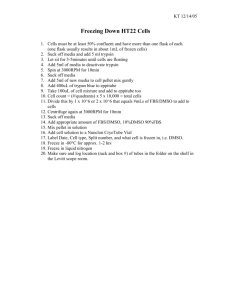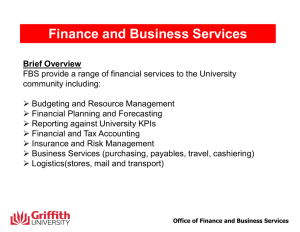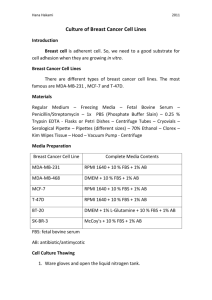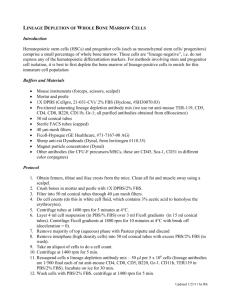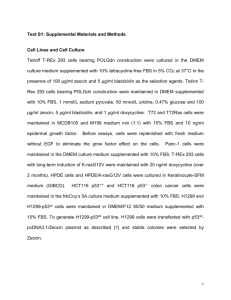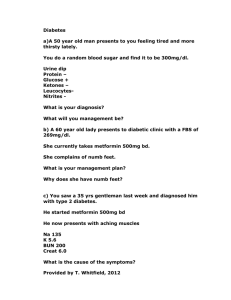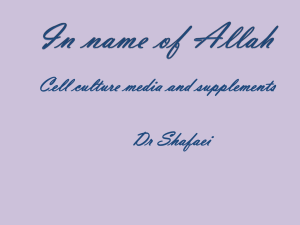Biology 102 - Academic Affairs
advertisement
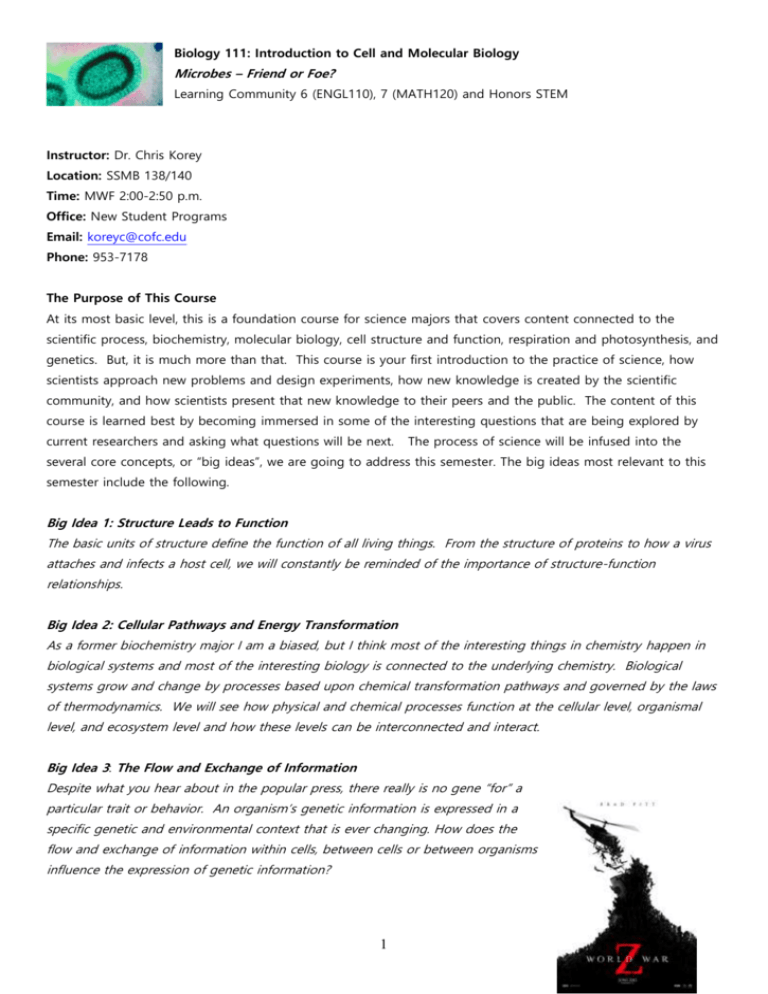
Biology 111: Introduction to Cell and Molecular Biology Microbes – Friend or Foe? Learning Community 6 (ENGL110), 7 (MATH120) and Honors STEM Instructor: Dr. Chris Korey Location: SSMB 138/140 Time: MWF 2:00-2:50 p.m. Office: New Student Programs Email: koreyc@cofc.edu Phone: 953-7178 The Purpose of This Course At its most basic level, this is a foundation course for science majors that covers content connected to the scientific process, biochemistry, molecular biology, cell structure and function, respiration and photosynthesis, and genetics. But, it is much more than that. This course is your first introduction to the practice of science, how scientists approach new problems and design experiments, how new knowledge is created by the scientific community, and how scientists present that new knowledge to their peers and the public. The content of this course is learned best by becoming immersed in some of the interesting questions that are being explored by current researchers and asking what questions will be next. The process of science will be infused into the several core concepts, or “big ideas”, we are going to address this semester. The big ideas most relevant to this semester include the following. Big Idea 1: Structure Leads to Function The basic units of structure define the function of all living things. From the structure of proteins to how a virus attaches and infects a host cell, we will constantly be reminded of the importance of structure-function relationships. Big Idea 2: Cellular Pathways and Energy Transformation As a former biochemistry major I am a biased, but I think most of the interesting things in chemistry happen in biological systems and most of the interesting biology is connected to the underlying chemistry. Biological systems grow and change by processes based upon chemical transformation pathways and governed by the laws of thermodynamics. We will see how physical and chemical processes function at the cellular level, organismal level, and ecosystem level and how these levels can be interconnected and interact. Big Idea 3: The Flow and Exchange of Information Despite what you hear about in the popular press, there really is no gene “for” a particular trait or behavior. An organism’s genetic information is expressed in a specific genetic and environmental context that is ever changing. How does the flow and exchange of information within cells, between cells or between organisms influence the expression of genetic information? 1 Our exploration of these big ideas will occur in the context of the microbial world of viruses and bacteria - a part of our world that is garnering greater scientific interest as new experimental tools allow us to delver deeper into their world. Some interesting factoids to whet your appetite: A liter of seawater contains at least 100 billion viruses and these viruses may turn over as much as 150 gigatons of carbon per year as a result of their host infection cycles. 1 The human body has over 100 trillion bacterial cells in and on it that are essential for its survival. 2 A spoonful of soil can have between 100 million and 1 billion bacteria that are essential for water dynamics, nutrient cycling, and disease suppression.3 If the popularity of the Walking Dead and World War Z say anything about our current human culture, our biggest fear is the emergence of a pandemic virus that will wipe out humanity…pass the popcorn!4 First Year Experience and General Education Learning Objectives: Completion of BIOL 111 & 111L/ BIOL 112 & 112L satisfies the College requirement for a general education science sequence. Please read the syllabus insert posted on OAKS to learn more about how this science sequence satisfies the general education requirement and the department learning objectives for the course. For some of you, this course will also fulfill your First Year Experience requirement. A description of the FYE learning objectives for this course is also available on OAKs. We will explore our big ideas and key concepts through several modules centered on viral/microbial biology. During each of our meetings the material will build upon previous class work and ask you to apply key concepts to biologically significant problems. The diagram below outlines our class structure and how each course activity is connected. Pre-Class Reading: Freeman, Biological Science 5th Edition - This is the textbook for this course as well as BIOL112 and BIOL211. It is abbreviated as FBS in the course outline. We will also be reading primary scientific papers and several chapters from an amazing short book called the Genetic Switch by Mark Ptashne (abbreviated GS and loaded as a PDF on OAKs). All readings outside of the text will be posted in OAKs. All pre-class readings are indicated in the course topics below. 1 Weitz and Wilhelm (2013) An Ocean of Viruses. The New Scientist 2 Robison et al. (2010) From Structure to Function: the Ecology of Host-Associated Microbial Communities 3 United States Department of Agriculture NRCS: soils.usda.gov/sqi/concepts/soil_biology/bacteria.html 4 Season 5 of The Walking Dead is returning soon. Best show on TV. 2 Pre-Class Reading Quiz: I encourage you to come to class prepared to engage with scientific problems and data. I will not be lecturing on the key concepts that you explore in your pre-class readings. These general key concepts will be applied to an interesting problem, often in microbial biology, in class so you’ll need to be prepared to make use of those key concepts. You will take an online quiz though the MasteringBIOLOGY companion site before almost every class to ensure that you have understood the concepts from the readings and to help me gauge if there are particular topics that are still unclear. There is no make up quiz if you miss taking it prior to class. Dynamic Study Modules/Synthesis Activities: The neuroscience of learning indicates that continuous practice and quizzing helps students to better understand material in a course. I have set up “Dynamic Study Modules” and “Synthesis Activities” to help create a format that promotes this type of practice. These modules will always be available to you during the semester, but completing them for course credit will be limited to each exam period. Course Engagement and Poll Everywhere: Every day in class we will work in small groups on scientific problems that will ask you to apply the key concepts, encourage critical thinking, and view our course material through real-life issues in microbial biology. During that discussion we will be using Poll Everywhere to answer questions and prompt discussion. This system works through your cell phones, so please bring them to class everyday. Participation grades will be based partly on participating actively in polling responses. In-Class Exams: There will be three in-class exams and a cumulative final (with some new material). The exams will be a combination of basic key concept questions similar to your pre-class reading quizzes, dynamic study modules/synthesis problems, and problem solving similar to our in-class work that asks you to apply the key concepts. I will post a practice exam for each section to help you prepare. Primary Literature Analysis: A significant portion of this class is dedicated to understanding the scientific process, how scientists design experiments, and how we as a community communicate our findings to our peers. This project will span the semester and ask you to analyze and write short analysis papers on primary research articles. There will be four of these papers due during the semester – covering a variety of interesting topics in viral and microbial biology. Each paper will allow you to improve your ability to analyze papers based on my written feedback. Science in the News: These are short one-paragraph summaries of an interesting article you found in the popular science press about something that was discovered about viruses or bacteria. These are optional assignments that will be posted to the OAKs discussion board. Course Reflective Essay: Almost all of you are connected to another class that provides a different perspective on the Biology course we will be journeying through together. As part of the end of the class work we will be doing, the Learning Community faculty will be asking you to reflect on your experience in the combined courses. Course Assignments and Points Each section of the course allows you to earn points towards your final grade in course. They come in a variety of flavors centered on different aspects of the course: 3 Exams Three In-Class Exams (Drop one – 200 points) 20% Final Exam (150 points) 15% Primary Literature Analysis Portfolio (250) 25% Course Engagement (50 points) 5% Dynamic Study Modules/Science in the News (150 points) 15% Course Reflective Essay (50 Points) 5% Pre-Class Reading Quizzes 15% Online Course Components OAKS is the College of Charleston’s course management system. It is an integral part of many of our courses here at the College. We will be making extensive use of it during the semester. There are many aspects to the site and I will introduce the functionality of it as the semester progresses. All course content and assignments will be found here. MasteringBIOLOGY (www.MasteringBiology.com) is the online learning system that is connected to your textbook. An access code for this site comes with the version of the book we are using for this class. We will make extensive use of the quiz and assignment function. You can also use the eText version of the book on line or download a version of the text to an iPad or Android tablets using the Pearson eText app. Our Course ID: MBKOREY65004 Academic Support Office Hours: I encourage you to see me as the first person that you go to when you are in need of additional help in my class or would like general advice about your academic path here at the college. As your FYE faculty member, I consider myself an unofficial advisor for your first year on campus. Please feel free to come by my office at any time. We will schedule my office hours together on the second day of class. I will also be happy to meet with you in my office at anytime by appointment. Synthesis Seminar: An integral part of this First Year Experience course is your Synthesis Seminar. It is part of our course requirements (factored in to our course participation) that you attend all of the Synthesis Seminar meetings. Honors students will meet this requirement with their Beyond George Street Seminar. Attendance and participation in the Synthesis Seminar is an essential piece of this course. An absence in the Synthesis Seminar counts as an absence in the course. Synthesis Seminar for LC 7 (MATH120) Peer Facilitator: Breighoné Brown Location: ECTR, 202 Time: Tuesdays, 12:15 to 1:05pm 4 Synthesis Seminar for LC 6 (ENGL110) Peer Facilitator: Kelsey Volmer Location: Maybank, 105 Time: Tuesdays, 12:15 to 1:05pm Supplemental Instruction: I strongly urge you to attend SI at least once weekly with Sierra Small, our SI Leader. It is fun, social, and provides another way of viewing our material – it is not remedial. Students who regularly attend SI outperform those who do not by nearly a full letter grade, on average. SI will be offered several times a week, announced in class. Center for Student Learning: I encourage you to utilize the Center for Student Learning’s (CSL) academic support services for assistance in study strategies and course content. They offer tutoring (including a new walk- in Science Tutoring Lab), Supplemental Instruction, study skills appointments, and workshops. Students of all abilities have become more successful using these programs throughout their academic career and the services are available to you at no additional cost. For more information regarding these services please visit the CSL website at http://csl.cofc.edu or call (843)953-5635. Course Policies and Grading Missing Class Time: Being in class is an essential component of our course. All the good stuff is going to happen in the interactions between us as we work through the material. If for whatever reason you cannot make it to class, it is your responsibility to communicate that to me and arrange to get any missed work or material from one of your fellow students. Students must provide a valid and documented excuse from the Undergraduate Dean’s Office in the case of missing an exam. Acceptable excuses include illness, personal tragedy or circumstances beyond the student’s control. Attendance is part of your course engagement grade for this class and your attendance record will always be available to you on OAKS. Seven absences from this course, excused or unexcused, will result in a your failing the course Tardiness: Showing up late to class is both disrespectful and prevents you and your fellow students from being fully engaged in the course. Showing up in the last quarter of the class meeting time will be treated as an absence. Course Grade: I will ask a lot of you in this class and I am confident that you are up to the challenge. There is no curve in this class; your grade depends only on your own effort put forth in the class. Grades will be assigned based on the total points you have accumulated. Grading Scale and Expectations: A (93.5-100), A- (90-93.49), B+ (88.5-89.9), B (83.5-88.49), B- (80-83.49), C+ (78.5-79.9), C (73.5-78.49), C- (70-73.49), D+ (68.5-69.9), D (63.5-68.49), D- (60-63.49), F (<60) Equal Access: I am happy to work with all students to ensure that they have equal access to the educational experience of this class. The College will make reasonable accommodations for persons with documented disabilities. Students should apply at the Center for Disability Services / SNAP, located on the first floor of the Lightsey Center, Suite 104. Students approved for accommodations are responsible for notifying me as soon as 5 possible and for contacting me one week before accommodation is needed. Honor Code and Academic Integrity Lying, cheating, attempted cheating, and plagiarism are violations of our Honor Code that, when identified, are investigated. Each instance is examined to determine the degree of deception involved. Incidents where I believe that a student’s actions are clearly related more to ignorance, miscommunication, or uncertainty, will be addressed by consultation with me. We will craft a written resolution designed to help prevent future repetition of this error in the future. This resolution, submitted by form and signed by both the student, and me is forwarded to the Dean of Students and remains on file. I will report cases of suspected academic dishonesty directly to the Dean of Students. A student found responsible for academic dishonesty will receive a XF in the course, indicating failure of the course due to academic dishonesty. This grade will appear on the student’s transcript for two years after which the student may petition for the X to be expunged. The student may also be placed on disciplinary probation, suspended (temporary removal) or expelled (permanent removal) from the College by the Honor Board. It is important for students to remember that unauthorized collaboration--working together without permission-is a form of cheating. Unless I specify that you can work together on an assignment and/or test, no collaboration is permitted. Other forms of cheating include possessing or using an unauthorized study aid (such as a PDA), copying from another’s exam, fabricating data, and giving unauthorized assistance. You can find a complete version of the Honor Code and all related processes in the Student Handbook Tentative Semester Schedule Day Date Read before Topic: Due Dates class: W 8-20 Introductions, Syllabus, Course Design F 8-22 CSL: Textbooks and Notetaking w/ Melissa Hortman The Case of Chronic Fatigue Syndrome and the XMRV Virus M 8-25 FBS 36 all Chronic Fatigue Syndrome, XMRV, and Viral Biology W 8-27 FBS 1.1-1.5 Chronic Fatigue Syndrome, XMRV and Experimental Design OAKS Reading F 8-29 OAKS Reading Chronic Fatigue Syndrome, XMRV, and Peer Review Avian Influenza: Combating Viral Infection and Spread M 9-1 FBS 2.1, 2.2 The Flu Virus and Hemagglutinin (part), 2.5 Key Concepts: Atoms & Bonds/ Carbon Skeletons/Functional 6 Grps W 9-3 FBS 3 all Crystal Structure of Hemagglutinin and Cell Attachment Key Concept: Protein Structure and Function/Enzymes F 9-5 FBS 2.3 The Chemistry of Viral Attachment Key Concepts: Thermodynamics and Energy M 9-8 FBS 5 all How Can the Virus Cross the Species Barrier? Key Concepts: Carbohydrate Structure W F 9-10 9-12 FBS 4 all Pandemic Viruses, Viral Genomes and Evolution FBS 36 Key Concepts: Nucleic Acids and Viral Genome Diversity FBS 6.1-6.2 and Breaking into the Cell-Viral Fusion Paper 2.2 Key Concepts: Lipid Structure/Membranes; Water Chemistry/pH Analysis 1 Due M 9-15 Science and Society Discussion: Influenza, Bioterrorism, and the Scientific Process W 9-17 F 9-19 Unit Review Activity Paper on OAKs Exam 1 Exam 1 Viral/Bacterial Pathogenesis and Toxins M 9-22 FBS 6.3-6.4 Bacterial Toxins Key Concepts : Membranes, Diffusion/Osmosis, Transport W 9-24 FBS 7.1-7.3, 7.5 Viral Replication in Eukaryotic vs Prokaryotic Cells Key Concepts: Prokayotic/Eukaryotic Cell Structures, Cellular Information Flow F 9-27 FBS 11.3 Enteroinvasive Pathogens – Sneaking into Cells Key Concepts: Cellular Communication, Cellular Information Flow and Signal Transduction M 9-29 FBS 7.6 Enteroinvasive Pathogens – Actin Comet Tails! Key Concepts: Cellular Information Flow, Cytoskeleton Dynamics W 10-1 Dr. Korey at a Conference – In Class SI Review F 10-3 TBD Getting In and Staying: Bacterial Endosymbionts and the Evolutionary Origins of Photosyntheis/Respiration M 10-6 FBS 8 all Key Concepts: Energy Transformation, Metabolic Pathways, Energy Transfer, ATP, Enzymes W 10-8 FBS 9.1-9.4 Key Concepts: Cellular Respiration, Energy Transformation F 10-10 FBS 9.5-9.6 Key Concepts: Fermentation, Energy Transformation Paper Analysis 2 Due M 10-13 FBS 10.1-10.3 Key Concepts: Photosynthesis, Light Reactions, Energy Transformation FBS 10.4 Key Concepts: Calvin Cycle, Energy Transformation W 10-15 F 10-17 Unit Review Activity M 10-20 Exam 2 Exam 2 7 Viruses, Cancer and Cell Division W 10-22 FBS 12.1 Normal Cell Division Key Concepts: Mitotic Cell Cycle, DNA synthesis, Cellular Signaling Pathways Th 10-23 F 10-24 Course Withdrawal Date: Last date to withdraw with a “W” FBS 15.3-15.5 Mistake Free Copying…Almost Key Concepts: DNA Synthesis and Repair M 10-27 FBS 12.3-12.4 Cells Gone Wild! Key Concepts: Cellular Signaling Pathways, Cell Cycle Control W Connecting the Semester Together – HPV and Cervical Cancer 10-29 The Genetics of Human HIV Resistance F 10-31 FBS 16 all It’s all about the mutations! Paper Key Concepts: Genes, Mutation, and Multiple Alleles Analysis 3 Due M 11-3 W 11-5 Fall Break FBS 13.1-13.2 Connecting Inheritance to Meiosis (monohybrid crosses) and 14.1-14.4 Key Concepts: Basic Inheritance Patterns, Meiosis, Probability, Information Flow F 11-7 FBS 14.4 Connecting Inheritance to Meiosis (dihybrid crosses) Key Concepts: Basic Inheritance Patterns, Meiosis, Probability, Information Flow M 11-10 FBS 14.6 Human Genetics and Pedigrees Key Concepts: Basic Inheritance Patterns, Meiosis, Probability, Information Flow W 11-12 Unit Review Problems F 11-14 Exam 3 Exam 3 Gene Expression in Context: Bacteriophage M 11-17 FBS 17.1-17.2 A Virus in Hiding Part I GS:Intro Key Concepts: Protein Structure, Nucleic Acid Structure, Transcription and RNA Polymerase W 11-19 GS: Ch. 1 A Virus in Hiding Part II Key Concepts: Protein Structure, Nucleic Acid Structure, Control of Gene Expression F 11-21 GS: Ch. 2 A Virus in Hiding Part III Key Concepts: Environmental Impacts on Gene Expression M 11-24 FBS 17.3-17.5 Translation Paper Key Concepts: Information Flow Analysis 4 Due W 11-26 No class, Thanksgiving holiday F 11-28 No class, Thanksgiving holiday M 12-1 Last day of class 8 W 12-3 Final Exam 12:00 – 3:00 pm (in our current classroom) 9 Final Exam

